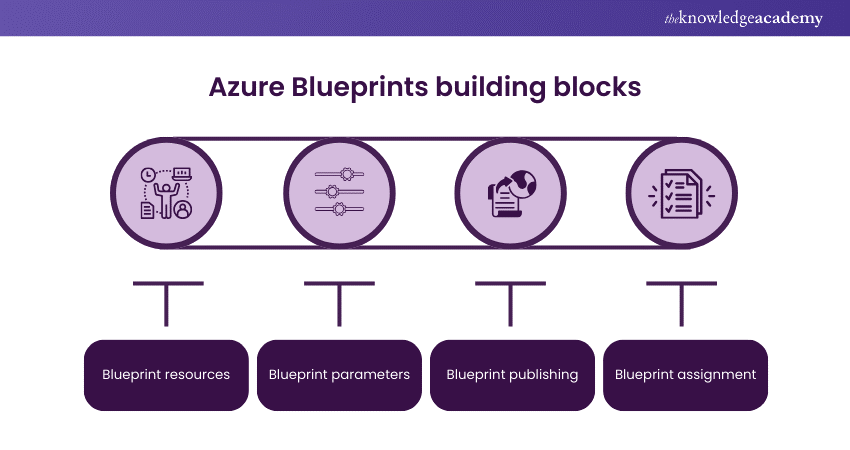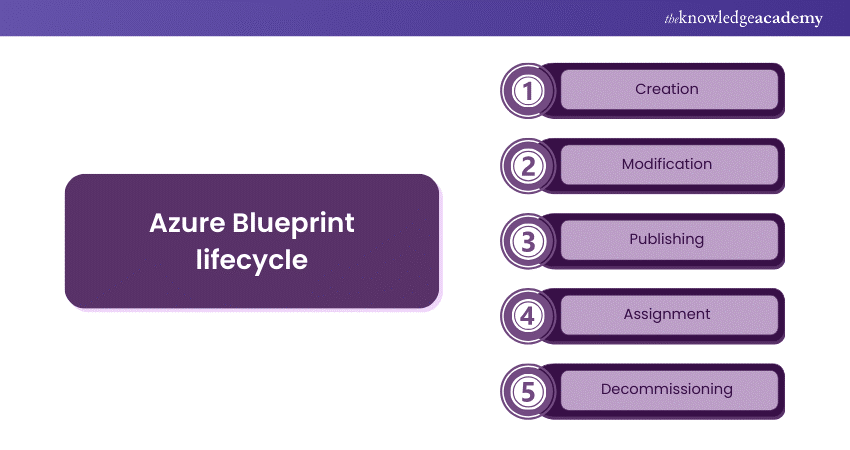We may not have the course you’re looking for. If you enquire or give us a call on +32 35001305 and speak to our training experts, we may still be able to help with your training requirements.
We ensure quality, budget-alignment, and timely delivery by our expert instructors.

When it comes to Cloud Computing, managing complex deployments in a consistent and compliant manner can be quite challenging. Azure Blueprints offers a structured solution by enabling organisations to define and replicate cloud environments efficiently, ensuring they meet all operational standards and requirements.
This blog delves into the Azure Blueprint lifecycle, a critical component for leveraging this powerful tool effectively. Understanding these stages not only aids in effective Blueprint management but also ensures that deployments are seamless and aligned with strategic business objectives. Let's explore each phase in detail.
Table of Contents
1) What is Azure Blueprint?
2) Azure Blueprints building blocks
3) Azure Blueprint lifecycle
4) Azure Blueprints naming limits
5) Azure Role-Based Access Control (RBAC)
6) Conclusions
What is Azure Blueprint?
Azure Blueprints is a service designed to facilitate the rapid and consistent deployment of Azure resources that conform to an organisation's specific standards, requirements, and overarching cloud architecture. This service provides a structured way to implement governance and set up complex environments efficiently, using a collection of predefined templates known as "Blueprints." These Blueprints ensure that every deployment is compliant with company policies and regulatory standards, streamlining the management process.
Azure Blueprints building blocks
Azure Blueprints are instrumental in managing cloud environments with precision and efficiency. This section delves deeper into the fundamental components that compose these Blueprints, ensuring a comprehensive understanding of how they function and are utilised within Azure.

Blueprint resources
Blueprint resources are the specific Azure resources that are outlined within a Blueprint. These can include a wide array of components, such as Virtual Machines (VMs) for computing power, network configurations for connectivity and security, and databases for data storage solutions. The selection and configuration of these resources are crucial as they define the structure and capabilities of the deployed environment.
Blueprint parameters
Parameters in Azure Blueprints act as variables that can be used to input custom values during the Blueprint Assignment. These parameters can be configured for different aspects, such as the size of Virtual Machines, the network range, or database capacities. The use of parameters significantly enhances the Blueprint’s flexibility and reusability. It allows the same Blueprint to be tailored to suit different environments or needs without altering the underlying logic or structure.
Blueprint publishing
Publishing a Blueprint is the act of making it available for use within an organisation's Azure environment. Once a Blueprint is created, it must be published before it can be assigned to any subscriptions. The publishing process involves versioning each Blueprint to keep track of changes and updates.
Blueprint assignment
Blueprint assignment is the application of a published Blueprint to an Azure subscription. This step is where the actual deployment of the specified resources takes place according to the parameters and resource definitions set within the Blueprint. During assignment, governance and compliance rules can be enforced, ensuring that the deployment strictly adheres to organisational policies and standards.
Learn the basics of Azure with our Microsoft Azure AI Fundamentals AI-900 Course – join today!
Azure Blueprint lifecycle
The lifecycle of Azure Blueprints is a crucial aspect to consider for ensuring efficient management, governance, and operational continuity in cloud deployments. It encompasses several stages, each of which plays a vital role in maintaining the integrity and effectiveness of Blueprints. Let’s find out all the stages:

a) Creation: The creation stage of an Azure Blueprint involves setting the foundational framework, defining the scope and structure of managed resources like Virtual Machines, networks, and databases. It also includes establishing the policies, resource groups, and role assignments that govern deployment, ensuring alignment with organisational standards from the start.
b) Modification: As operational needs evolve or as improvements are identified, the modification of an Azure Blueprint becomes necessary. This stage allows for the adjustment or enhancement of the Blueprint’s components, such as updating templates, refining resource configurations, or altering compliance policies.
c) Publishing: Once a Blueprint is finalised or updated, it moves into the publishing stage. Publishing a Blueprint validates its configuration against Azure’s compliance and policy standards to ensure it is ready for deployment. This phase marks the Blueprint as stable and ready for use.
d) Assignment: During the assignment stage, the Blueprint is applied to specific Azure subscriptions or resource groups. This triggers the actual deployment of the resources specified in the Blueprint according to the predefined configurations and parameters. It is at this point that the Blueprint's practical impact is realised.
e) Decommissioning: The decommissioning phase is reached when a Blueprint is no longer required or needs to be replaced. This stage involves safely winding down the Blueprint’s deployment, ensuring that all associated resources are appropriately managed to avoid service disruptions. Decommissioned Blueprints are then archived, preserving their configurations and associated data for historical analysis.
Understand Azure's integration for seamless deployment with our Designing and Implementing Microsoft DevOps Solutions AZ400 Course – join today!
Azure Blueprints Naming Limits
Naming conventions and limits are critical for organising resources. Proper naming practices not only facilitate easier management and identification of resources but also ensure compliance with Azure's platform constraints. This applies to various resources, including Azure Container Registry, where adhering to proper naming standards ensures consistency and efficient management across your Azure environment.
|
Aspect |
Limit |
|
Maximum length |
90 characters |
|
Minimum length |
1 character |
|
Allowed characters |
Alphanumeric, underscores, hyphens, and spaces |
|
Special characters |
Start and end with alphanumeric characters only |
|
Case sensitivity |
Names are case-insensitive |
|
Global uniqueness |
Not required; scoped within each subscription |
|
Keywords |
Avoid reserved words and overly generic terms |
Azure Role-Based Access Control (RBAC)
Role-Based Access Control (RBAC) within Azure Blueprints plays a pivotal role in defining who can manage and deploy Blueprints. This ensures that only authorised personnel have the ability to alter or deploy critical infrastructure components. By implementing RBAC, Azure provides a secure and efficient way to control access based on individual roles within the organisation, allowing for a clear separation of duties.
This level of specificity helps prevent unauthorised access and modifications, thereby protecting the integrity of the infrastructure and aligning it with compliance and security policies.
Conclusion
The deployment of Azure Blueprints is a game-changer for businesses seeking to enhance their cloud infrastructure management. By thoroughly understanding the stages, organisations can leverage Azure Blueprints to not only streamline their cloud architectures but also enhance their strategic deployment capabilities. As cloud environments become increasingly complex, the ability to manage these deployments will remain an indispensable skill for cloud professionals.
Understand how to build and deploy solutions using Azure services with our Microsoft Azure Fundamentals AZ-900 Certification Course – join today!
Frequently Asked Questions
What is the difference between Azure Blueprints and ARM?

Azure Blueprints and Azure Resource Manager (ARM) templates serve different purposes; while ARM templates are used for deploying specific Azure resources, Azure Blueprints allow for the creation of repeatable sets of Azure resources along with governance tools and policies.
How many parameters does an Azure Blueprint artifact have?

An Azure Blueprint artifact can have multiple parameters, but the exact number depends on the complexity and requirements of the Blueprint. These parameters are customisable and can be used to fine-tune the deployment settings.
What are the other resources and offers provided by The Knowledge Academy?

The Knowledge Academy takes global learning to new heights, offering over 3,000 online courses across 490+ locations in 190+ countries. This expansive reach ensures accessibility and convenience for learners worldwide.
Alongside our diverse Online Course Catalogue, encompassing 19 major categories, we go the extra mile by providing a plethora of free educational Online Resources like News updates, Blogs, videos, webinars, and interview questions. Tailoring learning experiences further, professionals can maximise value with customisable Course Bundles of TKA.
What is the Knowledge Pass, and how does it work?

The Knowledge Academy’s Knowledge Pass, a prepaid voucher, adds another layer of flexibility, allowing course bookings over a 12-month period. Join us on a journey where education knows no bounds.
What are related courses and blogs provided by The Knowledge Academy?

The Knowledge Academy offers various Microsoft Azure Certification Course, including Microsoft Azure Fundamentals AZ-900 Certification Course, Microsoft Azure Security Technologies AZ500 Course and DP-100 Azure Data Scientist Associate Certification Course. These courses cater to different skill levels, providing comprehensive insights into Azure Front Door.
Our Microsoft Technical Blogs cover a range of topics offering valuable resources, best practices, and industry insights. Whether you are a beginner or looking to advance your IT Security skills, The Knowledge Academy's diverse courses and informative blogs have you covered.
Upcoming Microsoft Technical Resources Batches & Dates
Date
 Microsoft Azure Fundamentals AZ-900 Certification
Microsoft Azure Fundamentals AZ-900 Certification
Fri 2nd May 2025
Fri 4th Jul 2025
Fri 5th Sep 2025
Fri 28th Nov 2025






 Top Rated Course
Top Rated Course



 If you wish to make any changes to your course, please
If you wish to make any changes to your course, please


